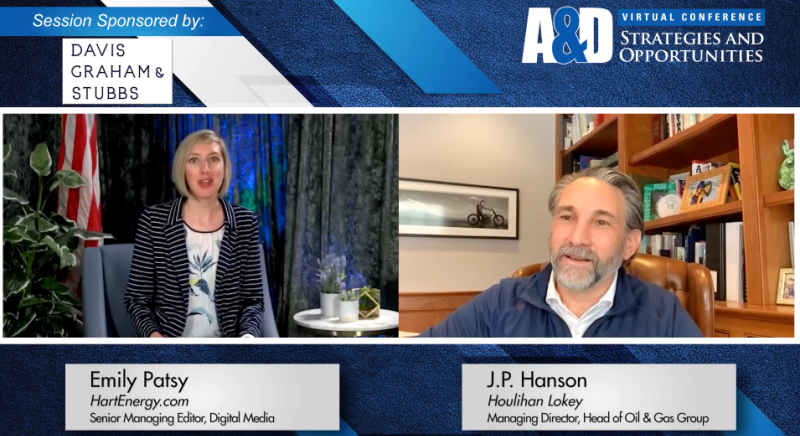Presented by:

[Editor's note: A version of this story appears in the April 2021 issue of Oil and Gas Investor magazine. Subscribe to the magazine here.]
The mileage had already worn smooth companies such as Oasis Petroleum Inc., Whiting Petroleum Corp. and Chesapeake Energy Corp. before 2020 and what was to come: an E&P demolition derby. The companies were plagued to varying degrees by huge amounts of debt and, abruptly, vanishing cash flow.

Austin T. Lee, an attorney with Bracewell, said bankruptcy can give companies and their new management teams the ability to shed G&A costs while also freeing themselves of unfavorable midstream contracts and other agreements.
Combined, the companies were saddled with $15.2 billion. But in less than a year, like the sly rolling back of a debt odometer, the three marquee names owed just $1.9 billion.
Their secret? Bankruptcy.
After years of chipping away at their debt, the sudden drop in commodity prices last year pushed the companies off the stock exchanges, miniaturized market values and, finally, forced E&Ps to yield to the courts.
They were not alone. Last year, E&Ps lugged a colossal $53 billion into federal courthouses, second only to 2016’s $56 billion.
For 12 months, the debt laden and financially unstable operators of upstream oil and gas played what was essentially one of worst games of musical chairs ever.
As usual, bondholders, creditors and E&Ps carrying bold red debt were trying to hold on for another season. Then commodity prices collapsed. The pandemic, an escalating price war and a world held hostage by disease caused oil prices to shrink.
“The music just kind of stopped for everybody,” said Austin T. Lee, an attorney with Bracewell.
But unlike the pruning of debt seen in 2016, E&Ps have largely seen their debt structures razed in the past 12 months. Newly retrofitted with streamlined staff, more promising cash flow and fiscally fit operations, the companies have a debt profile that surpasses some industry leaders.
UPDATE:
E&P Bankruptcies on Simmer in First Quarter
The question now is whether the companies are built to sell or built to last. The answer may be somewhere in between.
Lee said bankruptcy can give companies and their new management teams the ability shed G&A costs while also freeing themselves of unfavorable midstream contracts and other agreements.
“Then, maybe that asset is poised to operate a lot better and generate free cash flow,” Lee said. Companies could use the cash flow to reorient the company for a “build-to-last scenario, or just pay yourself back and get out of the deal,” he said. “Maybe that’s the build-to-last going forward, at least for a little bit.”
As Whiting entered bankruptcy on April Fools’ Day, it held $3.4 billion in debt. It exited bankruptcy in September with a mere $425 million balance. Oasis similarly flattened the curve, winnowing its $2.8 billion debt to just $340 million. And Chesapeake exited bankruptcy in February with $1.2 billion in debt, down from its June credit balance of $9 billion.
J.P. Hanson, managing director and head of the oil and gas group with Houlihan Lokey Inc., said the oil and gas industry has consolidation on the brain.
Companies such as Oasis, Whiting and Chesapeake and smaller companies, such as Extraction Oil and Gas Inc., emerged at 1.3 times leverage. Extraction tried to run an M&A process during its bankruptcy and, Hanson said, it is still searching for an M&A partner.
“All of that is to drive consolidation,” Hanson said of the scrubbed balance sheets. “But also to set up the capital structures such that if consolidation doesn’t happen, there’s a line of sight to have a long, flexible standalone [company].”
Selected 2020 Bankruptcy Exits |
||||
| Filed | Company | Exit | Pre-bankruptcy ($B) |
At Exit ($MM) |
| April | Whiting Petroleum Corp. | September 2020 | $3.4 | $425 |
| May | Ultra Petroleum Corp. | September 2020 | $5.6 | Eliminated $2B in debt |
| May | Unit Corp. | May 2020 | $1 | $180 |
| June | Chesapeake Energy Corp. | February 2021 | $9.1 | $1,271 |
| June | Extraction Oil & Gas Inc. | January 2021 | $1.6 | $265 |
| July | California Resources Corp. | October 2020 | $5.9 | $725 |
| July | Denbury Resources Inc. | September 2020 | $2.1 | $154 |
| September | Oasis Petroleum Inc. | November 2020 | $2.8 | $340 |
But even larger companies, including Chesapeake, are saying, “Hey, look, somebody may want to merge into us,” Hanson said. A reverse merger between a large private company and a recently emerged company could make sense given the difficulty in launching an upstream IPO. Such combinations could give companies complimentary assets and help solve balance sheet issues because of now low-levered publics.
“The entire mindset of the industry right now is consolidate. And if you can’t consolidate for some reason, then try to pretty up the capital structure as much as possible, so that you’ve got flexibility to live,” he said.
Chapter 22
It was an anomalous year of plague and price war. Commodity prices fell, then the death toll climbed. The globe stopped, but heads were still spinning.
“You had two black swan events,” Lee said. “There was a lot of confusion and zero conviction in the buyer universe. There was just a bigger pool of uncertainty that people were playing with than there was even in the prior downturn.”
Debt was different, too. Companies entering Chapter 11 bankruptcy saw their debt increasingly tied to secured lenders and banks. Secured debt had risen to 46% in 2020 compared to 35% in 2016, according to Haynes and Boone LLP.
Lawyers coined a new term for repeat bankruptcies: Chapter 22. Ultra Petroleum Corp., for instance, filed for bankruptcy for the second time in five years, according to Haynes and Boone.
“Obviously, last year was an anomaly for everybody in every single category of their lives,” Lee said. “The industry was having problems before all of that happened. I feel like a lot of the bondholders and different constituents and creditors …. were trying to work things out.”
Sidebar:
CRASH COURSE
Pick a downturn. Six years apart, 2014 and 2020 were distinctly different in that one was like being trapped in a slowly sinking ship and the other a passenger on a jetliner, going down.

The results, in either case, were not happy.
The pace at which oil and gas prices fell in 2020 far outpaced the 2014 downturn, said Duane Dickson, vice chairman and U.S. oil, gas and chemicals leader, with Deloitte LLP.
The downturn in 2014 lasted about 18 months. The 2020 crash nosedived in less than six months.
“The most recent crash also hit an industry already struggling with lower commodity prices and strained balance sheets,” Dickson said. “That has translated into a shorter restructuring cycle over the past year.”
In the previous downturn, the number of bankruptcies increased over a couple years before dropping back down. Last year, bankruptcies were concentrated in the first and second quarters.
By the second quarter, 30% of oil and gas businesses made up all defaults and included nine bankruptcies, six distressed exchanges and a missed interest payment, according to Moody’s Investors Service. Perhaps as telling, 38% of those oil and gas companies had previously defaulted.
Deloitte expects the pace of bankruptcies to slow in 2021.
E&Ps are showing a fundamental shift with cash flows, which for publicly traded E&Ps remain higher in 2020 than they did in 2015 and 2016.
Dickson said that’s indicative of companies’ efforts to control costs and boost production.
“Beyond that, management teams at many companies continue to emphasize value over volume and are credibly committing to limiting reinvestment in line with commodity prices,” he said.
That reflects a heightened shareholder focus on profitability and concerns over spending.
“That doesn’t take dealmaking off the table, but M&A will need to be focused on profitable assets with opportunities for synergies at the right price,” he said. “That has been what is driving the increase in low-premium, all-stock deals in places like the Permian.”
The biggest question remaining is how to maximize value, which is partly dependent on unpredictable commodity prices.
“I think there will be an expectation for management teams to continue moderating their rate of reinvestment even if WTI continues to remain elevated following the recent [February] winter storms,” he said. “That focus on reinvestment could mean more scrutiny over rig counts as well as the number of wells drilled and completed in a given quarter. Tighter purse strings may dampen some dealmaking, but it will also open opportunities for consolidation as companies optimize their portfolios and right size their rate of development.”
Companies hit by the sudden price swing faced quick solvency challenges. Instead of sliding into a prepackaged, negotiated bankruptcy, they had to scramble for immediate Chapter 11 cover. At the confluence of two disasters, Lee said all players were reluctant to make decisions, particularly in the early part of the year.
“I don't think anybody's problems got solved over that period. But I think that everybody experienced the same environment over the summer and into early fall. Sellers were unsure of what sort of future they were selling into and the bid-ask spread really couldn’t get closed for most deals.
Lee saw three broad “categories of buyers” emerge.
Public companies engaged with companies during court-ordered assets sales. Generally, public companies were in the hunt for strategic bolt-on assets in their fairway or close to it.
“With a few notable exceptions, most of the time they were trying to cherry pick the assets that they wanted to bid on and really just hung around the process, maybe because they had claims against the debtors in various capacities, maybe as a non-op under a [joint operating agreement],” he said.
More than anything, the public companies seemed to be keeping tabs on processes rather than interacting. “Outside of a few deals, I did not see a ton of real, genuine participation from public companies as buyers of full packages,” he said.
Most often buyers were after PDP assets.
“Oftentimes those were private equity funds with new teams looking to deploy capital in a blowdown scenario where they were comfortable hedging out their production for the life of those properties and focusing efforts on cost savings.”
Lee said in many cases those were the most competitive.
Private companies were also active, especially where they were “the natural acquirers and, in select situations, those companies participated in and were successful in buying neighbors out of bankruptcy.”
In such cases, the companies knew the assets well and were willing to take a bit more risk documenting the deal.
The other type of buyer became the new equity owner through a prepackaged or restructured deal. Such buyers included hedge funds and mezzanine funds who saw their equitization rise.
“Those people wanted to maximize the recovery on their investment, but they’re not looking to own and run an oil and gas company,” Lee said.
The other type of “buyer” constituted stakeholders that purchased revolvers or other debt which gave them the ability to come in as the new equity owners, usually through a pre-packaged or restructured deal. Much of the interest in these types of positions came from hedge funds and other mezzanine players who specialize in purchasing distressed debt positions.
“These groups wanted to maximize the recovery on their investment, but in most cases they're not looking to own and run an oil and gas company for the long run,” Lee said. But, maintaining or converting their position to equity until a company is in a better situation sell is something they are willing to do.
The curse of tourists

The eventual fate of the restructuring Class of 2020 will depend on who is now backing the companies, Hanson said. Some may try to sell fast, even at a loss. Others have far more staying power because of their slimmed debt profiles.
“It depends on who the stakeholders are,” he said. “You can’t really compare it to the restructuring wave in 2015 to 2016, because that was driven much more by high velocity, short-term traders.”
Hanson dismisses those investors as “energy industry tourists, at best.” He added, “They’re glorified day traders, and there’s no love lost, if you can’t tell.”
The restructurings after 2016 weren’t deep enough, in Hanson’s view, because such traders were looking for “an immediate pop in commodity price” to turn a profit. Their bet was a rapid recovery of commodity prices.
“I heard repeatedly during that restructuring period that there was this great V-shape recovery to oil price in 2009, 2010, and that’s exactly what’s going to happen in 2014.”
Hanson said those traders had no sense of the industry’s supply and demand dynamics or the broader market forces that were at play in 2014 and 2015. Such traders wanted a quick payoff and, in the process, engineered inadequate bankruptcies “to overlever these companies so they have to restructure again,” Hanson said. “The mindset is baffling to me.”
The shift in 2021 to a far more reasonable debt structure reflects a greater degree of patience from a different type of equity holder: regular weight, high-yield investors at household names such as Fidelity Investments Inc., Franklin and Lord Abbett.

Watch J.P. Hanson’s presentation at
Hart Energy’s A&D Strategies and Opportunities
Virtual Conference
Hanson said, “You have to look at the capital structure and say, ‘Who are the real stakeholders? Who are the owners of this business? What are their appetites? Are they patient enough to hold onto this for a little bit? Are they that short-term investor, high-velocity trader mentality?’”
What he sees are reoriented equity owners. Some are looking for the first opportunity to “punch out” after bankruptcy.
Hanson pointed to Enerplus Corp.’s deal to purchase Bruin E&P’s Williston Basin assets for $465 million. Bruin emerged from bankruptcy in September after restructuring. Bruin offloaded $840 million in debt during its restructuring, then announced it would sell. Hanson said Bruins backers “wanted out of Dodge” and with cash.
Their clearing price was “still 50 cents on the dollar from recovery of their original debt,” he said. “And as soon as that, or plus, hit that number, they were out.”
But the stakeholders for Oasis, Whiting and Extraction are different.
“They’re playing this longer term now,” he said. “They have the staying power to say, ‘We’re going to be patient. We’re going to look for the right opportunity.’”
Recommended Reading
TPH: Lower 48 to Shed Rigs Through 3Q Before Gas Plays Rebound
2024-03-13 - TPH&Co. analysis shows the Permian Basin will lose rigs near term, but as activity in gassy plays ticks up later this year, the Permian may be headed towards muted activity into 2025.
E&P Highlights: April 15, 2024
2024-04-15 - Here’s a roundup of the latest E&P headlines, including an ultra-deepwater discovery and new contract awards.
E&P Highlights: March 15, 2024
2024-03-15 - Here’s a roundup of the latest E&P headlines, including a new discovery and offshore contract awards.
TotalEnergies Acquires Eagle Ford Interest, Ups Texas NatGas Production
2024-04-08 - TotalEnergies’ 20% interest in the Eagle Ford’s Dorado Field will increase its natural gas production in Texas by 50 MMcf/d in 2024.
E&P Highlights: March 4, 2024
2024-03-04 - Here’s a roundup of the latest E&P headlines, including a reserves update and new contract awards.






